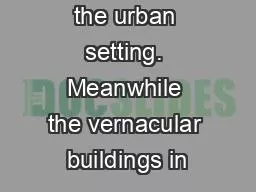

representing the survival of Manggarai traditional architecture Noteboom a Dutch administrator who stayed in Manggarai for 11 months in 1939 and published the earliest accounts of architecture in Ma ID: 832121
Download Pdf The PPT/PDF document "buildings in the urban setting. Meanwhil..." is the property of its rightful owner. Permission is granted to download and print the materials on this web site for personal, non-commercial use only, and to display it on your personal computer provided you do not modify the materials and that you retain all copyright notices contained in the materials. By downloading content from our website, you accept the terms of this agreement.
buildings in the urban setting. Meanwhil
buildings in the urban setting. Meanwhile the vernacular buildings in the rural setting have not been recognized as potential sources to elaborate the interior studies and practices across architectural types (classic, modern, traditional). Although the interireprese
nting the survival of Manggarai traditio
nting the survival of Manggarai traditional architecture? Noteboom, a Dutch administrator who stayed in Manggarai for 11 months in 1939 and published the earliest accounts of architecture in Manggarai provided description of original Manggarai house (Allerton, 2013).
He outlined two types of large houses, a
He outlined two types of large houses, an elongated and round houses that inhabited by several dozen of families. However as the houses of these large structures were relatively poorly built and unhealthy, the occupants were consequently very prone to all kinds of dis
eases that eventually the Dutch colonial
eases that eventually the Dutch colonial government decided to pull down them all. After independence under Indonesia government, Manggarai traditional structure had been continually fought in the name of Òsanitation and development (pembangunan)Ó and in return the go
vernment introduced new brick houses wit
vernment introduced new brick houses with windows. Furthermore the government forcibly relocated mountain villages to lowland and pulled down the original villages. Wae Rebo appeared to be the only remained mountain village that depicted the where people have a com
munal ritual. The arrangement and orient
munal ritual. The arrangement and orientation of the seventh mbaru niang is an open U shape facing communityÕs central openair altar. Figure 4: the Circular Pattern of Mbaru Niang (round house) and Lingko(spider web fields) Source: Antar (eds.), 2010 THE HOUSE U
NIT The conical houses at the height of
NIT The conical houses at the height of approximately 13 meters are identical, following the fix traditional form, layout and function. Entering through the front door of the house, one should leaving sandals by the ladder at the entrance. The ground floor called tend
adoorway and very small windows. child
adoorway and very small windows. children and carried them into their individual rooms. In this case unlike much important ethnographic studies in vernacular houses in Southeast Asia concentrated on cooking and eating (Carsten, 1997), in Wae Rebo the practice and pl
ace of sleeping is crucial. Young childr
ace of sleeping is crucial. Young children should always sleep in the household room with their mother and father. Room and Ritual The connection between individuals, rooms and fate are demonstrated guardian spirits commonly referred among Wae Rebo people as body s
ibling (couple, their children and thei
ibling (couple, their children and their room. When the baby born the cord was cut by the bamboo blade (lampek), which then was wrapped in a scrap of cloth and pushed into the bamboo wall of motherÕs room. It is one of the first connections made between baby and its
room. It is the remaining part of the
room. It is the remaining part of the bamboo stick, known as lambo, which most obviously links a baby with its room. After the baby birth, the babyÕs father will bang the meter-long The naming ritual begin with the cracking of an egg beneath the supporting posts of
the house, after which the lambo stick
the house, after which the lambo stick is pulled out of . Mothers and daughters or groups of sisters tend to eat together, crowd together near the hearth, spooning rice and vegetables from shared plates. In this case, unlike the industrial model which tend communi
cated by the form and configuration of m
cated by the form and configuration of mbaru niang, the ritual in individual rooms and the behavior patterns of the inhabitants. Living spaces in village level and domestic level delrnacular dwelling heavily expressed through symbolism. Referred to the anthropologic
al study by Allerton, the role of cublic
al study by Allerton, the role of cublicle room in Wae Rebo shift through time, from a centre for a newly married couple, to a nurturing place for babies and children, from a sleeping place for female kin to an origin path for male sibling. Room have at their core ten
sion between the separation and incorpor
sion between the separation and incorporation of family members, as well as a tension between relationship of sibling and those of marriage. From the perspective of ritual, room is closely knitted with bodies and souls, especially during the key passages of child-birt